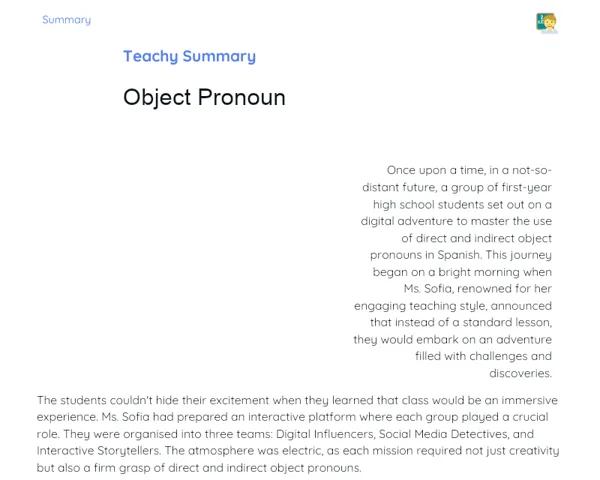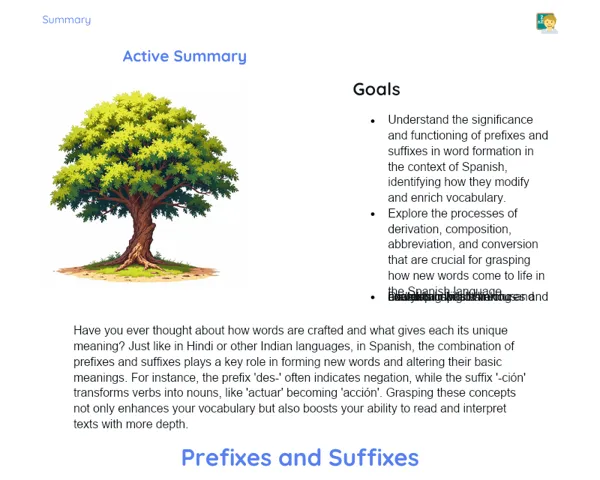Summary Tradisional | Accentuation
Contextualization
Accentuation in Spanish is a key aspect of spelling and proper pronunciation of words. Unlike Portuguese, which has its own set of accentuation guidelines, Spanish has unique features that dictate how and when words should be accented. Mastering these rules is crucial to avoid confusion and to ensure clear and precise written communication.
In Spanish, the positioning of the stressed syllable—the syllable that carries the most emphasis in pronunciation—is vital for correct accentuation. Words can be categorized into four main types: agudas, graves (or llanas), esdrújulas, and sobreesdrújulas. Each of these categories has specific rules that outline when a word should carry an accent. Furthermore, the use of the diacritical accent is significant in differentiating words that share the same spelling but have different meanings. Familiarizing students with these rules will help them apply accentuation accurately, enhancing their reading and writing skills in Spanish.
To Remember!
Classification of Words According to Stress
In Spanish, words are classified based on where the stressed syllable falls, which is the syllable that stands out the most in pronunciation. This classification is crucial for determining the rules of accentuation. The four main categories are: agudas, graves (or llanas), esdrújulas, and sobreesdrújulas.
Agudas words are those that stress the last syllable. They are accented when they end in 'n', 's', or a vowel. Examples include 'canción' and 'café'.
Graves words, or llanas, have the stressed syllable at the penultimate position. They receive an accent when they do not end in 'n', 's', or a vowel. Examples include 'árbol' and 'azúcar'.
Esdrújulas and sobreesdrújulas words have the stressed syllable in the antepenultimate or before the antepenultimate position, respectively. These words always carry an accent. Examples include 'teléfono' and 'dígamelo'.
-
Agudas words: stressed on the last syllable; accented when ending in 'n', 's', or a vowel.
-
Graves words: stressed on the penultimate syllable; accented when not ending in 'n', 's', or a vowel.
-
Esdrújulas and sobreesdrújulas words: stressed on the antepenultimate or before the antepenultimate syllable; always accented.
Accentuation Rules for Agudas Words
Agudas words stress the last syllable. In Spanish, these words receive a graphic accent (tilde) when they end in 'n', 's', or a vowel. This rule is vital to separate words that may be easily confused in writing and pronunciation.
For instance, the word 'camión' is an agudas word and is accented because it ends in 'n'. Without the accent, it might be confused with another similar-sounding word. Another example is 'café', which is also an agudas word and is accented since it ends in a vowel.
The accentuation rule for agudas words helps maintain clarity in written communication, preventing misunderstandings and clearly showing which syllable is stressed. It is important to practice identifying agudas words and applying the accentuation rule correctly to enhance writing precision in Spanish.
-
Agudas words have the last syllable as stressed.
-
They receive an accent when ending in 'n', 's', or a vowel.
-
Examples: 'camión', 'café'.
Accentuation Rules for Graves Words
Graves words, also known as llanas, stress the penultimate syllable. In Spanish, these words receive a graphic accent when they do not end in 'n', 's', or a vowel. This rule counters that for agudas words and is equally important for clarity in writing.
An example of a graves word is 'árbol'. The stressed syllable is 'ár', and the word receives an accent because it does not end in 'n', 's', or a vowel. Another example is 'lápiz', where the stressed syllable is 'láp' and the word receives an accent for the same reason.
Understanding and correctly applying the accentuation rules for graves words is vital to prevent common mistakes in Spanish writing. Regular practice aids in internalizing the rules and improving spelling accuracy.
-
Graves words have the penultimate syllable as stressed.
-
They receive an accent when not ending in 'n', 's', or a vowel.
-
Examples: 'árbol', 'lápiz'.
Accentuation of Vowels
Vowels in Spanish are categorized as strong (a, e, o) and weak (i, u). The interplay of these vowels influences the accentuation of words and must be well understood to apply the accentuation rules correctly.
When a weak vowel is next to a strong vowel in the same syllable, it forms a diphthong and typically is not accented, unless the weak vowel is stressed. For instance, in the word 'díaz', the vowel 'i' is stressed, thereby giving the word an accent.
If two strong vowels are together, each creates its own syllable, and the word is accented according to the general accentuation rules. For example, the word 'poeta' has two syllables with strong vowels and adheres to the standard accentuation rules.
Grasping the dynamics between strong and weak vowels is crucial for accurately applying the accentuation rules and avoiding common writing errors.
-
Strong vowels: a, e, o.
-
Weak vowels: i, u.
-
Diphthongs generally are not accented unless the weak vowel is stressed.
Key Terms
-
Accentuation: The use of graphic accents to signify the stressed syllable of a word.
-
Agudas words: Words with the last syllable stressed.
-
Graves (llanas) words: Words with the penultimate syllable stressed.
-
Esdrújulas words: Words with the antepenultimate syllable stressed.
-
Sobreesdrújulas words: Words with the stressed syllable before the antepenultimate.
-
Strong vowels: Vowels 'a', 'e', 'o'.
-
Weak vowels: Vowels 'i', 'u'.
-
Diacritical accent: An accent used to differentiate words with the same spelling but different meanings.
Important Conclusions
Accentuation in Spanish is a fundamental component of spelling and correct word pronunciation. Unlike Portuguese, which has its specific accentuation rules, Spanish features distinctive characteristics that dictate how and when to accent words. Grasping these rules is essential to prevent misunderstandings and ensure that written communication is both clear and precise.
In Spanish, understanding the position of the stressed syllable—the one that carries the most emphasis in pronunciation—is crucial for proper accentuation. Words can be categorized into four primary types: agudas, graves (llanas), esdrújulas, and sobreesdrújulas. Each category possesses specific rules concerning when a word should be accented. Additionally, employing the diacritical accent is essential to distinguish words that, despite identical spellings, have differing meanings. Familiarity with these rules will empower students to apply accentuation accurately, thereby enhancing their writing and reading proficiency in Spanish.
Study Tips
-
Regularly revisit the accentuation rules with practical examples to reinforce understanding.
-
Engage in exercises that involve identifying and correcting accentuation errors in words to solidify learning.
-
Utilize dictionaries and online resources for verifying the correct accentuation of unfamiliar words.



